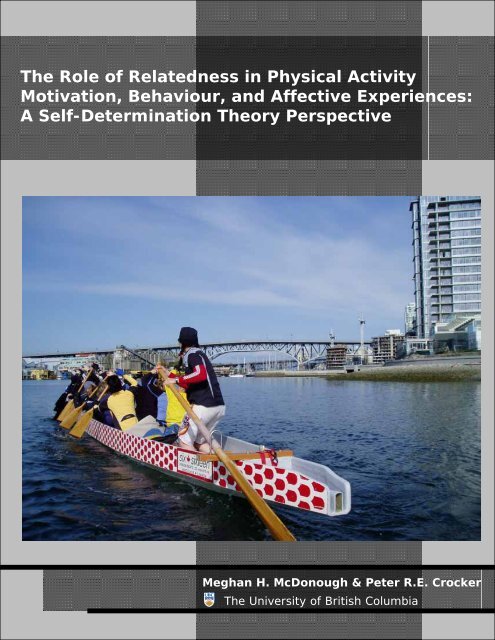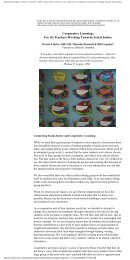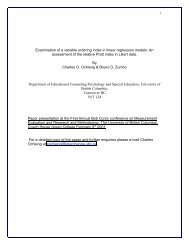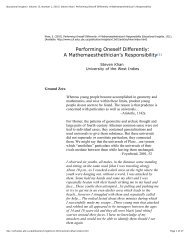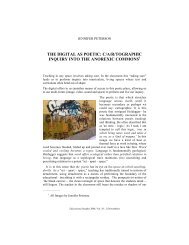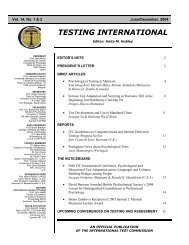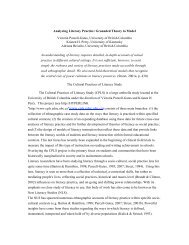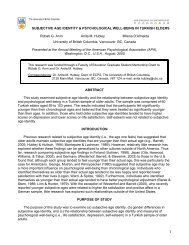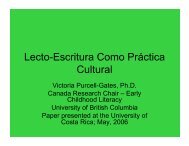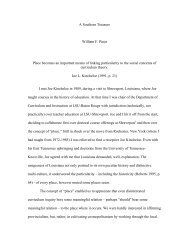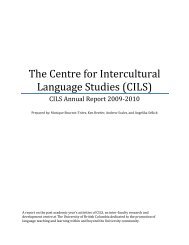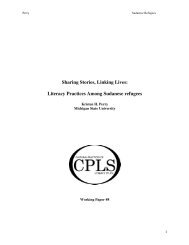The Role of Relatedness in Physical Activity Motivation, Behaviour ...
The Role of Relatedness in Physical Activity Motivation, Behaviour ...
The Role of Relatedness in Physical Activity Motivation, Behaviour ...
You also want an ePaper? Increase the reach of your titles
YUMPU automatically turns print PDFs into web optimized ePapers that Google loves.
<strong>The</strong> <strong>Role</strong> <strong>of</strong> <strong>Relatedness</strong> <strong>in</strong> <strong>Physical</strong> <strong>Activity</strong><br />
<strong>Motivation</strong>, <strong>Behaviour</strong>, and Affective Experiences:<br />
A Self-Determ<strong>in</strong>ation <strong>The</strong>ory Perspective<br />
Meghan H. McDonough & Peter R.E. Crocker<br />
<strong>The</strong> University <strong>of</strong> British Columbia
THE ROLE OF RELATEDNESS IN PHYSICAL ACTIVITY MOTIVATION, BEHAVIOUR,<br />
AND AFFECTIVE EXPERIENCES: A SELF-DETERMINATION THEORY PERSPECTIVE<br />
Introduction<br />
Meghan H. McDonough & Peter R.E. Crocker, UBC<br />
Despite overwhelm<strong>in</strong>g evidence that physical activity is critical for health<br />
and the widespread dissem<strong>in</strong>ation <strong>of</strong> this message <strong>in</strong> the popular press,<br />
only 39% <strong>of</strong> Canadian adults are active enough to take advantage <strong>of</strong> the<br />
health benefits <strong>of</strong> physical activity (Craig et al, 2001). Most research<br />
exam<strong>in</strong><strong>in</strong>g predictors <strong>of</strong> physical activity focuses on either <strong>in</strong>dividual<br />
cognitive factors such as perceptions <strong>of</strong> competence, or broad social<br />
determ<strong>in</strong>ants such as socio-economic status, and does not adequately<br />
address “micro-environmental” <strong>in</strong>fluences, <strong>in</strong>clud<strong>in</strong>g <strong>in</strong>terpersonal<br />
relationships (K<strong>in</strong>g et al, 2002).<br />
Self-Determ<strong>in</strong>ation <strong>The</strong>ory (Deci & Ryan, 1985, 1991) suggests that people<br />
experience more self-determ<strong>in</strong>ed (or <strong>in</strong>ternally controlled) types <strong>of</strong><br />
motivation when the activities they participate <strong>in</strong> make them feel that<br />
they have autonomy (the power to make their own choices),<br />
competence (the ability to effectively perform the behaviour), and<br />
relatedness (authentic social connections with others) <strong>in</strong> their physical<br />
activity environment. More self-determ<strong>in</strong>ed types <strong>of</strong> motivation are<br />
desirable because they are associated with more positive experiences<br />
and cont<strong>in</strong>ued motivation to participate. Even with<strong>in</strong> this theoretical<br />
framework, however, there is limited research on how social factors<br />
contribute to motivation <strong>in</strong> physical activity. Furthermore, there is little or<br />
no research on how social factors contribute to motivation among adults<br />
<strong>in</strong>volved <strong>in</strong> a team activity such as dragon boat<strong>in</strong>g, where participants<br />
must work together to achieve common goals.<br />
Purpose<br />
<strong>The</strong> aims <strong>of</strong> this project were to exam<strong>in</strong>e (1) whether various social<br />
relationship factors contribute to perceptions <strong>of</strong> relatedness; (2) whether<br />
relatedness, competence, and autonomy predict physical activity<br />
motivation, behaviour, and affective experience; (3) how these process<br />
are <strong>in</strong>fluenced by gender and age across the adult lifespan; and (4)<br />
whether a coach-based <strong>in</strong>tervention can effectively enhance social<br />
relationships, motivation, affect, and behaviour among adult dragon<br />
boaters. To address these aims, two separate studies were conducted.
Study 1<br />
Study 1 addressed the first three purposes listed above us<strong>in</strong>g a crosssectional<br />
survey <strong>of</strong> adult dragon boat participants.<br />
Participants<br />
558 adults from 75 different dragon boat teams<br />
Age: 19-83 (average = 45.09)<br />
Gender: 72% female<br />
Ethnicity: predom<strong>in</strong>antly Caucasian (70%) and Asian (24%)<br />
Education: 88% had at least some post-secondary education<br />
Socioeconomic Status: Average <strong>in</strong>come <strong>of</strong> 4% above the prov<strong>in</strong>cial<br />
median (i.e., approx. $22,880)<br />
Average length <strong>of</strong> time <strong>in</strong> dragon boat: 3.62 years (SD = 3.46)<br />
Average length <strong>of</strong> time on their current team: 2.54 years (SD = 2.23)<br />
Average # practices per week: 1.93 (SD = .66)<br />
Average # months per year practic<strong>in</strong>g: 6.77 (SD = 2.77)<br />
Procedures<br />
Questionnaires were distributed to teams before or after a practice.<br />
Volunteers completed questionnaires and returned them to the<br />
researcher personally or via mail. Questionnaires conta<strong>in</strong>ed measures<br />
assess<strong>in</strong>g social support, peer acceptance, friendship quality, autonomy,<br />
competence, relatedness, motivation, positive and negative affect,<br />
physical self-worth, and physical activity, along with demographic<br />
<strong>in</strong>formation. Questionnaires were anonymous.<br />
Results<br />
What types <strong>of</strong> social relationship elements predict feel<strong>in</strong>gs <strong>of</strong> relatedness?<br />
1. Peer acceptance (feel<strong>in</strong>g accepted and liked by one’s team-mates)<br />
2. Amount <strong>of</strong> social support (the degree to which other people provide<br />
help or assistance to support one’s dragon boat<strong>in</strong>g)<br />
3. Positive friendship quality (the degree to which the relationship with<br />
one’s closest friend <strong>in</strong> dragon boat<strong>in</strong>g is characterized by<br />
supportiveness, enhancement <strong>of</strong> self-esteem, loyalty, <strong>in</strong>timacy, hav<strong>in</strong>g<br />
th<strong>in</strong>gs <strong>in</strong> common, and companionship)<br />
4. Social support network size (the number <strong>of</strong> people who provide you<br />
with social support)<br />
5. Age was also a factor <strong>in</strong> predict<strong>in</strong>g relatedness, with older participants<br />
experienc<strong>in</strong>g higher levels <strong>of</strong> relatedness.<br />
<strong>The</strong>se f<strong>in</strong>d<strong>in</strong>gs suggest that all <strong>of</strong> these different aspects <strong>of</strong> social<br />
relationships contribute to people experienc<strong>in</strong>g relatedness, or feel<strong>in</strong>g<br />
authentic social connections with others <strong>in</strong> dragon boat.
Are autonomy, competence, and relatedness all important predictors <strong>of</strong><br />
motivation among dragon boaters?<br />
Yes, competence, relatedness, and autonomy all predict motivation.<br />
Competence and relatedness were the strongest predictors, support<strong>in</strong>g<br />
the hypothesis that feel<strong>in</strong>g socially connected with others is an important<br />
predictor <strong>of</strong> motivation <strong>in</strong> dragon boat. Age and gender were also<br />
predictors, with women and older participants tend<strong>in</strong>g to have more selfdeterm<strong>in</strong>ed<br />
motivation for dragon boat.<br />
<strong>The</strong>se f<strong>in</strong>d<strong>in</strong>gs suggest that feel<strong>in</strong>g socially connected to others is an<br />
important contributor to motivation for dragon boat.<br />
How do autonomy, competence, relatedness, and motivation l<strong>in</strong>k to<br />
outcomes such as emotions and behaviour <strong>of</strong> dragon boaters?<br />
Autonomy, competence, relatedness, and self-determ<strong>in</strong>ed motivation<br />
predict positive and negative affect (emotions), but only competence<br />
perceptions predict physical self-worth and physical activity. This means<br />
that people who feel that they have more choice and power over their<br />
dragon boat decisions, feel that they are good at dragon boat, feel that<br />
they have mean<strong>in</strong>gful social connections to others <strong>in</strong> their dragon boat<br />
group, and participate for self-determ<strong>in</strong>ed reasons (e.g., because they<br />
like do<strong>in</strong>g the activity itself, or because it is important to them) have more<br />
positive and less negative experiences <strong>in</strong> dragon boat. However, feel<strong>in</strong>g<br />
that they are good at dragon boat<strong>in</strong>g was the only th<strong>in</strong>g that contributed<br />
to hav<strong>in</strong>g positive perceptions <strong>of</strong> themselves physically, and be<strong>in</strong>g more<br />
physically active overall.<br />
<strong>The</strong>se f<strong>in</strong>d<strong>in</strong>gs suggest that people who score higher on autonomy,<br />
competence, relatedness, and self-determ<strong>in</strong>ed motivation tend to have<br />
more positive experiences <strong>in</strong> dragon boat, and that those who feel that<br />
they are good at dragon boat feel better about themselves physically and<br />
are more physically active.<br />
Major conclusions:<br />
Social relationships play an important role <strong>in</strong> motivation for dragon<br />
boat<strong>in</strong>g among adults. More positive social relationships are associated<br />
with better motivational pr<strong>of</strong>iles, more positive experiences, and more<br />
physical activity among participants.
Study 2<br />
Study 2 exam<strong>in</strong>ed (1) whether hav<strong>in</strong>g a coach use more cooperative<br />
types <strong>of</strong> activities <strong>in</strong> practice as opposed to more <strong>in</strong>dividually focused<br />
activities contributes to more positive social relationships, motivation, and<br />
outcomes among dragon boaters; and (2) whether changes <strong>in</strong><br />
relatedness predict changes <strong>in</strong> self-determ<strong>in</strong>ed motivation.<br />
Participants<br />
210 adults from 12 different dragon boat teams and their 14 coaches<br />
Age: 19-66 (average = 32.08)<br />
Gender: 60% male<br />
Ethnicity: predom<strong>in</strong>antly Asian (58%) and Caucasian (36%)<br />
Education: 95% had at least some post-secondary education<br />
Socioeconomic Status: Average <strong>in</strong>come <strong>of</strong> 4% below the prov<strong>in</strong>cial<br />
median (approx. $21,120)<br />
Average length <strong>of</strong> time <strong>in</strong> dragon boat: 4.81 years (SD = 3.96)<br />
Average length <strong>of</strong> time on their current team: 2.74 years (SD = 2.73)<br />
Average # practices per week: 2.30 (SD = .57)<br />
Average # months per year practic<strong>in</strong>g: 7.68 (SD = 1.41)<br />
Procedures<br />
Coaches were contacted and provided with <strong>in</strong>formation about the study.<br />
Coaches who consented to participate had their teams randomly<br />
assigned to the cooperative or <strong>in</strong>dividualistic learn<strong>in</strong>g condition by the<br />
researcher flipp<strong>in</strong>g a co<strong>in</strong>. <strong>The</strong> researcher met with the team to expla<strong>in</strong><br />
the study, distribute consent forms, and answer questions. Approximately<br />
1 week later, the researcher met with the team aga<strong>in</strong> so that those<br />
paddlers who volunteered to participate could complete the time 1<br />
questionnaire. Coaches were then tra<strong>in</strong>ed to carry out the learn<strong>in</strong>g<br />
condition assigned to their team. Coaches then used those procedures<br />
with their teams dur<strong>in</strong>g practices for eight weeks. Details <strong>of</strong> the<br />
cooperative and <strong>in</strong>dividualistic procedures can be obta<strong>in</strong>ed upon<br />
request from the researcher (contact <strong>in</strong>formation is provided at the end <strong>of</strong><br />
the report), but essentially the cooperative condition <strong>in</strong>volved activities<br />
and drills that required <strong>in</strong>teraction and communication among team<br />
members, while the <strong>in</strong>dividualistic condition <strong>in</strong>volved activities and drills<br />
that had paddlers work <strong>in</strong>dependently and focus on their own needs and<br />
technique. At the end <strong>of</strong> the eight weeks, paddlers completed a second<br />
questionnaire.
Results<br />
Did the <strong>in</strong>tervention result <strong>in</strong> changes <strong>in</strong> social relationships, motivation,<br />
and affective outcomes?<br />
Only <strong>in</strong> a very limited way. Peer acceptance <strong>in</strong>creased over the 8 weeks<br />
similarly <strong>in</strong> both the cooperative and <strong>in</strong>dividualistic conditions. Because<br />
the changes were similar <strong>in</strong> both conditions it is impossible to determ<strong>in</strong>e<br />
whether both <strong>in</strong>terventions had the same positive effect, or whether peer<br />
acceptance simply improved over time, unrelated to the <strong>in</strong>terventions.<br />
Perceptions <strong>of</strong> autonomy, however, <strong>in</strong>creased significantly <strong>in</strong> the<br />
<strong>in</strong>dividualistic condition, but rema<strong>in</strong>ed unchanged <strong>in</strong> the cooperative<br />
condition, suggest<strong>in</strong>g that activities that allow paddlers to focus on their<br />
own <strong>in</strong>dividual improvement enhances feel<strong>in</strong>gs <strong>of</strong> control and personal<br />
power <strong>in</strong> dragon boat.<br />
<strong>The</strong>se f<strong>in</strong>d<strong>in</strong>gs suggest that <strong>in</strong>dividualistic learn<strong>in</strong>g activities enhance<br />
perceptions <strong>of</strong> autonomy among dragon boaters. It is also possible that<br />
both cooperative and <strong>in</strong>dividualistic activities help enhance peer<br />
acceptance, but more research is needed to fully understand these<br />
effects.<br />
Did changes <strong>in</strong> relatedness predict changes <strong>in</strong> self-determ<strong>in</strong>ed<br />
motivation?<br />
Yes, <strong>in</strong>dividual changes <strong>in</strong> perceptions <strong>of</strong> relatedness over the course <strong>of</strong><br />
the eight weeks were associated with changes <strong>in</strong> self-determ<strong>in</strong>ed<br />
motivation. This f<strong>in</strong>d<strong>in</strong>g provides even stronger evidence than the f<strong>in</strong>d<strong>in</strong>g<br />
from study 1 that relatedness predicts motivation, as this shows that<br />
changes <strong>in</strong> the two variables over time are associated.<br />
This f<strong>in</strong>d<strong>in</strong>g provides further support for the l<strong>in</strong>k between relatedness and<br />
self-determ<strong>in</strong>ed motivation.<br />
Major conclusions:<br />
More support is found suggest<strong>in</strong>g that social relationships play an<br />
important role <strong>in</strong> motivation for dragon boat<strong>in</strong>g among adults. <strong>The</strong><br />
<strong>in</strong>tervention strategies tested here had limited effects on social<br />
relationships and motivation, but suggest that future work explor<strong>in</strong>g<br />
whether motivation and activity can be enhanced through social<br />
<strong>in</strong>terventions may prove useful.
Acknowledgements<br />
Thanks to the many paddlers, coaches, managers, capta<strong>in</strong>s, and<br />
organizers who made this study possible by volunteer<strong>in</strong>g to complete<br />
questionnaires, take part <strong>in</strong> the <strong>in</strong>tervention study, or help us make<br />
connections with teams to f<strong>in</strong>d participants for this project.<br />
Thanks to Julia Pilliar and Ryan O’Shea for their help collect<strong>in</strong>g data for this<br />
project.<br />
Fund<strong>in</strong>g for this research was provided by:<br />
<strong>The</strong> Social Sciences and Humanities Research Council <strong>of</strong> Canada<br />
<strong>The</strong> Michael Smith Foundation for Health Research<br />
Future Directions and Additional Information<br />
Results <strong>of</strong> this project will be presented at conferences and published <strong>in</strong><br />
academic journals <strong>in</strong> the future. <strong>The</strong> first <strong>of</strong> such endeavours is a<br />
conference presentation at the North American Society for the<br />
Psychology <strong>of</strong> Sport and <strong>Physical</strong> <strong>Activity</strong> (NASPSPA) <strong>in</strong> Denver, CO <strong>in</strong><br />
June, 2006. Further <strong>in</strong>formation on this and other publications will be<br />
posted on the UBC Sport and Exercise Psychology lab website<br />
(www.hk<strong>in</strong>.educ.ubc.ca/behavioural/<strong>in</strong>dex.html) <strong>in</strong> the future.<br />
For more <strong>in</strong>formation on this study, please contact Meghan McDonough at<br />
meghanmcdonough@telus.net or (604) 822-0219.<br />
References<br />
Craig, C.L., Cameron, C., Russell, S.J., & Beaulieu, A. (2001). Increas<strong>in</strong>g<br />
physical activity: Support<strong>in</strong>g children's participation. Ottawa, ON:<br />
Canadian Fitness and Lifestyle Research Institute.<br />
Deci, E.L., & Ryan, R.M. (1985). Intr<strong>in</strong>sic motivation and self-determ<strong>in</strong>ation<br />
<strong>in</strong> human behavior. New York: Plenum Press.<br />
Deci, E.L., & Ryan, R.M. (1991). A motivational approach to self:<br />
Integration <strong>in</strong> personality. In R. Dierstbier (Ed.), Nebraska symposium<br />
on motivation. Vol. 38. Perspectives on motivation (pp. 237-288).<br />
L<strong>in</strong>coln, N.E.: University <strong>of</strong> Nebraska.<br />
K<strong>in</strong>g, A.C., Stokols, D., Talen, E., & Brass<strong>in</strong>gton, G.S. (2002). <strong>The</strong>oretical<br />
approaches to the promotion <strong>of</strong> physical activity: Forg<strong>in</strong>g a<br />
transdiscipl<strong>in</strong>ary paradigm. American Journal <strong>of</strong> Preventive<br />
Medic<strong>in</strong>e, 23, 15-25.


